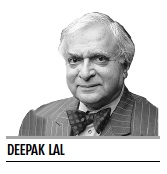 In a cashless economy, it would be difficult to distinguish electronic money from interest-bearing electronic bonds, and monetary policy would not be feasible
In a cashless economy, it would be difficult to distinguish electronic money from interest-bearing electronic bonds, and monetary policy would not be feasible
One of the shifting objectives adduced for the 2016 demonetisation is to reduce the cash-to-GDP (gross domestic product) ratio of the economy. Instead of cash the use of digital means to perform the transactions function of money is to be encouraged, as unlike the anonymity of cash these transactions leave a trace which the authorities can monitor. This it is claimed would reduce illegal transactions which are largely based on cash because of its anonymity. But, what of the costs to all those who want to make legal cash transactions? The anonymity of cash in this context is part of the case for individual liberty. If the state is predatory, then the anonymity of cash transactions allows the potential prey to at least protect part of their ‘property’ from the state’s predation. The argument for giving greater power to the state to regulate the economy, in response to the economy’s attempts to resist and circumvent regulation, is to condone taking steps on Hayek’s The Road to Serfdom. Limiting cash transactions will allow the state to control more than just illegal transactions. Just as Aadhaar, which was supposed to be only used for receiving welfare payments, has been gradually expanded to include bank transactions and mobile telephony, a wholesale switch from cash to digital transactions is the path to the surveillance state which is being established in China, but which must be resisted by every means in a constitutionally liberal India. The chief academic proponent of a cashless economy is the highly respected Harvard economist Kenneth Rogoff. In his book The Curse of Cash he bases his case in part on an attack on the illegal economy, but also argues that it would make it easier to implement negative interest rates when the economy is in a Keynesian ‘liquidity trap’. In an earlier column (“After the Great Fall”, September 2010), I had argued that, as the late Allan Meltzer showed in his magisterial A History of the Federal Reserve, this is based on a misunderstanding of the transmission mechanism of monetary policy, which works through changes in broad money through the ‘real balance’ effect and not through changes in interest rates. The zero bound on interest rates is irrelevant to carrying out an expansionary monetary policy through open market operations, as the recent experience of using QE (quantitative easing) to deal with the Great Recession has shown. To argue for a cashless economy with its costs in terms of individual liberty to deal with the paper tiger of the Keynesian ‘liquidity trap’ is reprehensible. Moreover, as Rogoff citing a 1980’s paper by Neil Wallace (American Economic Review 71(3):267-75) recognises there are various serious problems in conducting monetary policy in a cashless economy. The government monopoly in issuing a non-interest-bearing fiat currency has various consequences. The first is that it allows the government to gain ‘seigniorage’: The large profits the government earns from its monopoly on paper money which costs nothing to print, but can be spent to acquire real resources at its face value. These will be lost to a fiscally constrained government. The second is that, the distinction between clearing banks and non-bank financial intermediaries is based on the ability of banks to create money through their cash balances at the central bank.
A clearing bank holds deposits in cash from non-banks, repaying deposits in notes, and making payments for depositors by settlements in cash through an account in the central bank. When a clearing bank extends a loan, it adds to its assets and simultaneously creates deposit liabilities against itself, increasing the broad money supply at ‘the stroke of a pen’. This ability to create money out of thin air is limited by the bank’s capital and cash. As cash can be borrowed from the central bank, the ultimate constraint on its ability to create money is its capital. But it is only because banks take in cash deposits — Keynes’s ‘widow’s cruse’— that they can create money.
The whole system also depends upon the government preventing the use of interest-bearing government debt for transactions purposes. For without this prohibition the intrinsically worthless fiat currency would collapse, leaving a currency 100 per cent backed by gold or silver as the only alternative. In a cashless economy the currency would become completely electronic, losing — like government bonds today — its anonymity. This would make it difficult for electronic money from being distinguished from interest-bearing electronic bonds, and monetary policy as we now know it would not be feasible. If cash remains king, there is still the open question of the nominal anchor in a fiat currency-based monetary system. The correct answer in my view was given in the 1970’s by the Nobel laureate James Meade in his Nobel lecture on ‘The Meaning of ‘Internal Balance’”. He argued that, external balance in a country’s external payments was best maintained through flexible exchange rates, while for internal balance (full employment and price stability), total money incomes should be stabilised through monetary policy. He was advocating the targeting of nominal GDP rather than just inflation in monetary policy — as has become commonplace around the world since its adoption of inflation targeting by New Zealand in March 1990. This has now been taken up by the Harvard economist Jeffrey Frankel, who has pronounced “The death of inflation targeting” (VOX, June 19, 2012, http://voxeu.org). He cites the mistake made by the European Central Bank (ECB) in July 2008 in raising interest rates just as the world was sliding into the Great Recession, based on its aim of countering the effect of a rise in the oil price on the consumer price index (CPI). The correct response to this ‘terms of trade’ shock (the rise in the price of its major import) is not to tighten monetary policy but to accommodate the adverse shock. This error prompted by inflation targeting was compounded by its failure to deal with asset market bubbles in the US. Hence there is now a movement in the blogosphere led by Lars Christensen of The Market Monetarist website advocating nominal GDP targeting. I have much sympathy with their programme, and certainly given the continuing complaints about the neglect of growth in the Reserve Bank of India’s (RBI) conduct of monetary policy, it may informally seek to adopt nominal GDP targeting (as the Chinese central bank has been reported to have done), but keep its inflation target to anchor inflation expectations. It should not, however, have any truck with the political desire to create a cashless economy.
Read original article here… Deepak Lal is the James S. Coleman Professor Emeritus of International Development Studies at the University of California at Los Angeles, professor emeritus of political economy at University College London, and a senior fellow at the Cato Institute. He was a member of the Indian Foreign Service (1963-66) and has served as a consultant to the Indian Planning Commission, the World Bank, the Organization for Economic Cooperation and Development, various UN agencies, South Korea, and Sri Lanka. From 1984 to 1987 he was research administrator at the World Bank. Lal is the author of a number of books, including The Poverty of Development Economics; The Hindu Equilibrium; Against Dirigisme; The Political Economy of Poverty, Equity and Growth; Unintended Consequences: The Impact of Factor Endowments, Culture, and Politics on Long-Run Economic Performance; and Reviving the Invisible Hand: The Case for Classical Liberalism in the 21st Century.


